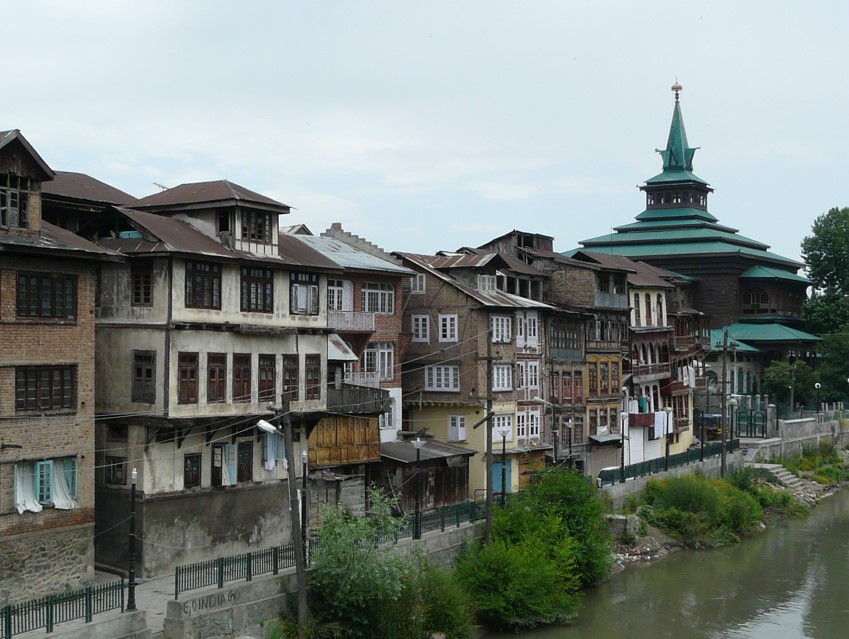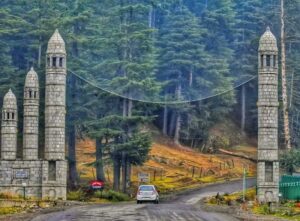As someone who has spent a lifetime wandering the intricate lanes of Srinagar’s Old City, I’ve watched countless visitors drift away on shikaras, never discovering the beating heart of my homeland. This guide reveals the Srinagar we Kashmiris treasure—beyond the picture-perfect Dal Lake that graces your postcards.
Beyond the Postcard: The Real Srinagar Old City
When outsiders imagine our beloved Srinagar, they envision tranquil Dal Lake waters. They picture shikaras gliding silently and floating markets with lotus blooms. However, there’s another Srinagar—my Srinagar Old City. It’s ancient, vibrant, and pulsating with life beyond the lake’s serene embrace.
In this authentic Srinagar Old City, my grandparents taught me to haggle for copper samovars. Meanwhile, my father showed me how to select the ripest plums in hidden markets. Throughout my childhood, prayer calls mingled with the rhythmic sounds of artisans at work. Consequently, every stone in Srinagar Old City whispers stories of empires, saints, and generations of craftspeople who shaped our cultural identity.
Immersed in Srinagar Old City: Our Living Heritage
Step into Srinagar Old City—Shehr-e-Khaas as we call it. You’ll immediately understand why we Kashmiris consider it our true home. The narrow gullies (lanes) buzz with unique energy. Undoubtedly, you won’t find this atmosphere at tourist houseboats. Furthermore, bakers announce fresh tchot (Kashmiri bread). Their calls mix with the metallic symphony of coppersmiths. At the same time, kahwe fragrance brews in samovars. It drifts through air already rich with seekh kababs and freshly pressed walnut oil aromas.
Essential Quarters of Srinagar Old City to Explore
Maharaj Gunj: The Royal Market
Maharaj Gunj dates back to Maharaja Ranbir Singh’s reign in the 1880s. It isn’t just our oldest commercial center. Instead, it’s where generations of my family sourced everything from wedding trousseaus to kitchen essentials. The market divides into specialized sections. These include Kral Khaar (potters’ street), Wagam Gor (vegetable market), and Zangir Mohalla (locksmiths’ quarter).
Narrow alleys showcase traditional wooden buildings with distinctive dajji diwari construction. These timber frameworks filled with brick masonry feature ornate hanging balconies. As a result, they’ve sheltered shoppers from rain and snow for centuries. Look up to admire intricate wood carvings that tell our architectural heritage story.
Local Experience: Join us for the early morning ritual of selecting fresh bread from the kandur (traditional baker). My favorite is the girda—a round, firm bread perfect for noon chai (salt tea) dipping. Come around 7 AM when breads emerge hot from clay tandoors. Subsequently, you’ll become part of a cherished daily tradition.
Best Time to Visit: Early mornings (7-9 AM) during summer months (May-June). Light filters through ornate wooden lattices then. Consequently, it creates dancing patterns on ancient stone pathways. The summer heat hasn’t peaked yet. Therefore, you’ll see merchants arranging their wares with artistic precision—a sight unchanged for centuries.
Zaina Kadal: The Bridge of Life
This historic bridge spans the Jhelum River. It’s not merely a crossing—it’s the lifeline connecting Srinagar Old City’s two halves. Built during Sultan Zain-ul-Abidin’s reign in the 15th century, we Kashmiris consider Zaina Kadal the true heart of downtown Srinagar Old City.
Although the bridge has been reconstructed numerous times, it always maintains its character. It serves as more than infrastructure—it’s our community gathering space. During summer evenings, elders perch along its edges with fishing lines. Meanwhile, the surrounding areas house our finest artisans—papier-mâché masters whose workshops I visited countless times as a child.
Local Experience: In late afternoon, join locals at small riverside chai shops near the bridge. Order kahwe (saffron tea with almonds) in a traditional samovar. Afterwards, watch the light play on the river while engaging in adda (leisurely conversation).
Nowhatta: The Quarter of Nine Markets
Nowhatta forms the spiritual and cultural nucleus of Srinagar Old City. Its name derives from “Nawa-haat” or “nine markets.” Centered around the magnificent Jama Masjid, this neighborhood has been our community’s gathering place for centuries.
The expansive square surrounding the mosque transforms throughout the day. In early mornings, fruit vendors arrange produce in colorful pyramids. Additionally, bakers fire up their tandoors. By afternoon, it becomes a busy marketplace. Everything from hand-embroidered shawls to traditional Kashmiri wedding attire changes hands. When Friday prayers conclude, thousands of worshippers fill the square. Consequently, they linger to socialize, discuss community matters, and patronize surrounding shops.
Local Experience: Visit on a Friday and explore the vibrant market outside Jama Masjid after prayers. Find everything from homemade achar (pickles) to hand-carved walnut wood items. Moreover, don’t miss street food stalls selling monji gaade (fish fritters) and masala tsot (spiced bread). These local favorites rarely appear in tourist restaurants.
Architectural Treasures of Srinagar Old City
Jama Masjid: Our Sacred Center
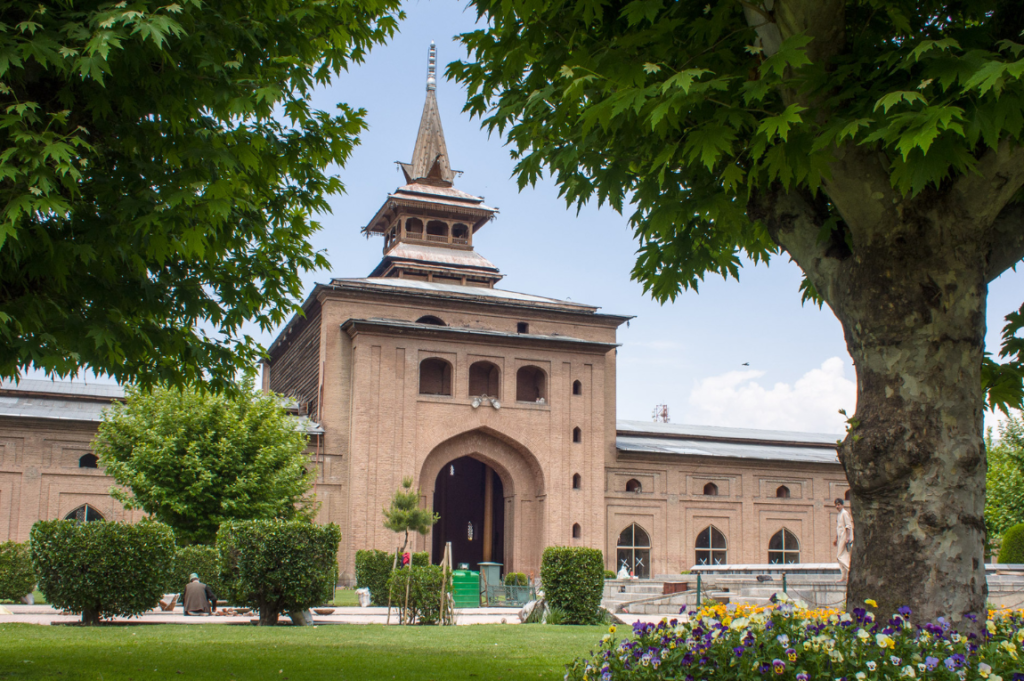
Sultan Sikandar built Jama Masjid initially in 1394. Since then, it has been lovingly restored multiple times. Our Jama Masjid isn’t just an architectural marvel—it’s the living center of our spiritual and community life. The 378 deodar wood columns support its massive structure. Therefore, they have witnessed centuries of prayers, celebrations, and historical upheavals.
Most visitors miss the bustling ecosystem surrounding the mosque. The expansive market outside transforms throughout seasons. Winter brings vendors selling pherans (traditional woolen cloaks) and kangris (portable fire pots). Meanwhile, spring features sellers with freshly harvested morel mushrooms from mountain forests.
Khanqah Shah-e-Hamdan: Spiritual Heritage
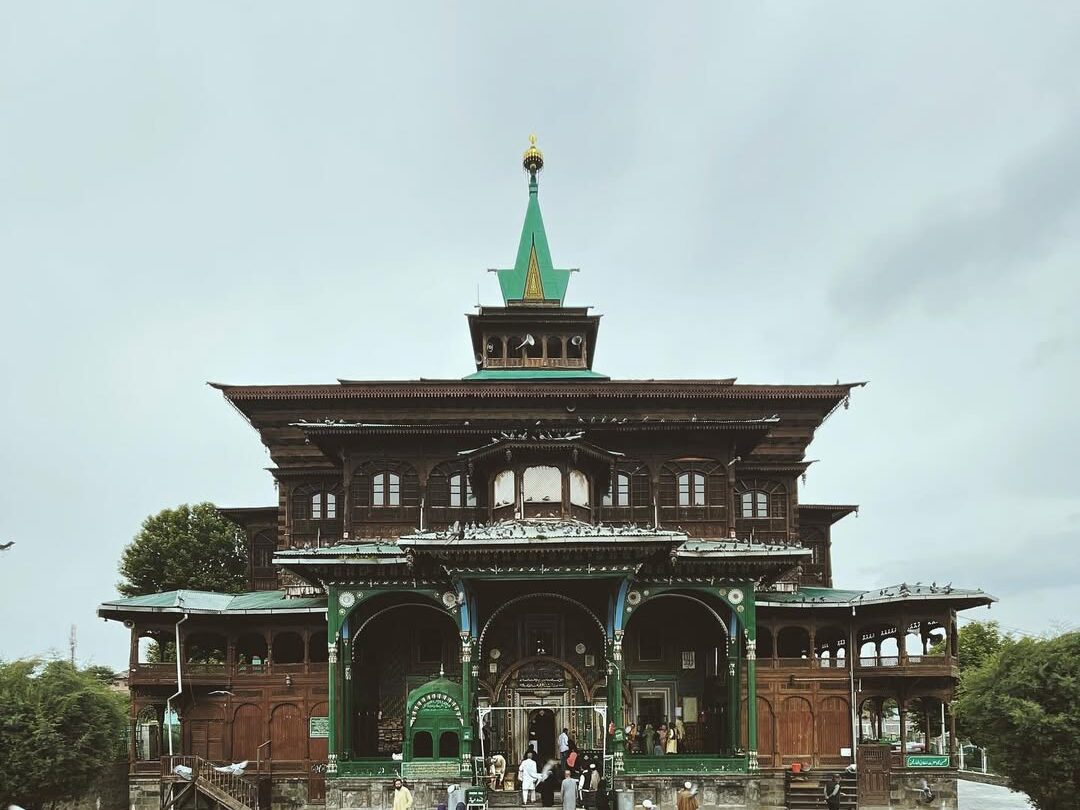
This shrine along the Jhelum River honors Mir Sayyid Ali Hamadani. The Persian Sufi saint profoundly shaped Kashmir’s cultural and religious identity. For us Kashmiris, this isn’t just a historical monument. On the contrary, it’s where we turn in times of need, celebration, and contemplation.
The building represents the pinnacle of traditional Srinagar Old City architecture. Every inch covers in intricate papier-mâché patterns, walnut wood carvings, and colored glass work. Furthermore, what makes it truly special is how the interior transforms throughout the day. Light filters through colored glass windows. As a result, it creates an ever-changing atmosphere that we believe reflects spiritual enlightenment’s many facets.
Historical Gems in the Old Quarter
Pathar Masjid (The Stone Mosque): Unlike our traditional wooden architecture dominating Srinagar Old City, this grey limestone mosque stands distinct. Empress Nur Jahan commissioned it. Thus, it testifies to Mughal influence. Local stone carvers still point out distinctive motifs blending Persian aesthetics with Kashmiri craftsmanship.
Budshah Tomb: This final resting place of Sultan Zain-ul-Abidin’s mother showcases Central Asian architectural influence. Consequently, it connects us to our pre-Mughal heritage. The area surrounding the tomb once centered manuscript production. Even today, a few elderly calligraphers maintain studios nearby.
Paradise Realized: Majestic Gardens Surrounding Srinagar Old City
While tourists admire the aesthetic beauty of our Mughal Gardens, we Kashmiris experience them differently. They are living extensions of our cultural identity. These spaces intertwine daily life, history, and natural beauty.
Nishat Bagh: The Garden of Joy
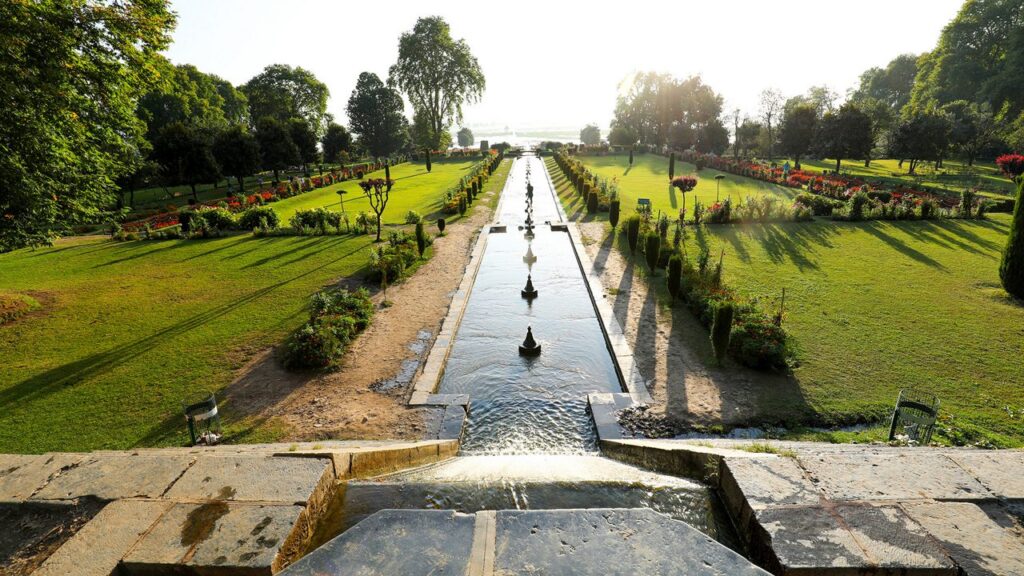
Nishat Bagh features twelve terraces representing zodiac signs. They cascade down toward Dal Lake. It’s more than a historical attraction—it’s where my family has celebrated spring picnics for generations.
Terraces of Tradition
For locals, each terrace serves a traditional purpose. Elders gather on upper levels with panoramic views. There, they discuss community matters. The middle terraces become impromptu cricket grounds for youngsters on school holidays. Furthermore, young couples and poets seeking inspiration prefer lower levels near water channels.
Massive chinar trees serve as natural timepieces for us. Some were planted during Asif Khan’s original construction. Their changing colors mark seasonal passage more reliably than any calendar. In autumn, local artists gather beneath them. Eventually, they capture spectacular foliage on canvas.
Nishat Bagh Experiences
Local Experience: Join Kashmiri families for trami—communal meals served in large copper plates. Four people share each plate while seated on grass under chinar trees. During spring weekends, many families bring elaborate home-cooked feasts. If invited to share (which happens often), accepting shows good manners. Afterwards, try nadru monje (lotus stem fritters)—a picnic specialty rarely found in restaurants.
The garden’s fountains and water channels aren’t merely decorative. In fact, they’re engineering marvels that local hydraulics experts still study. The water system operates entirely through gravity without mechanical pumps. Moreover, it uses principles developed centuries ago.
Best Time to Visit: Early mornings (7-9 AM) in spring (April-May). Local flower enthusiasts come then to sketch blooming tulips and magnolias. Tourists haven’t arrived yet. Therefore, you’ll experience the garden as locals do—as a living space rather than a monument.
Did You Know? During summer’s height, the garden’s ingenious cooling system works wonders. Lower terraces can be up to 10 degrees cooler than surrounding areas. That’s why local elders often gather here during afternoon heat waves. Subsequently, they seek refuge in precise spots where Mughal nobles once lounged.
Shalimar Bagh: Where Life Events Unfold
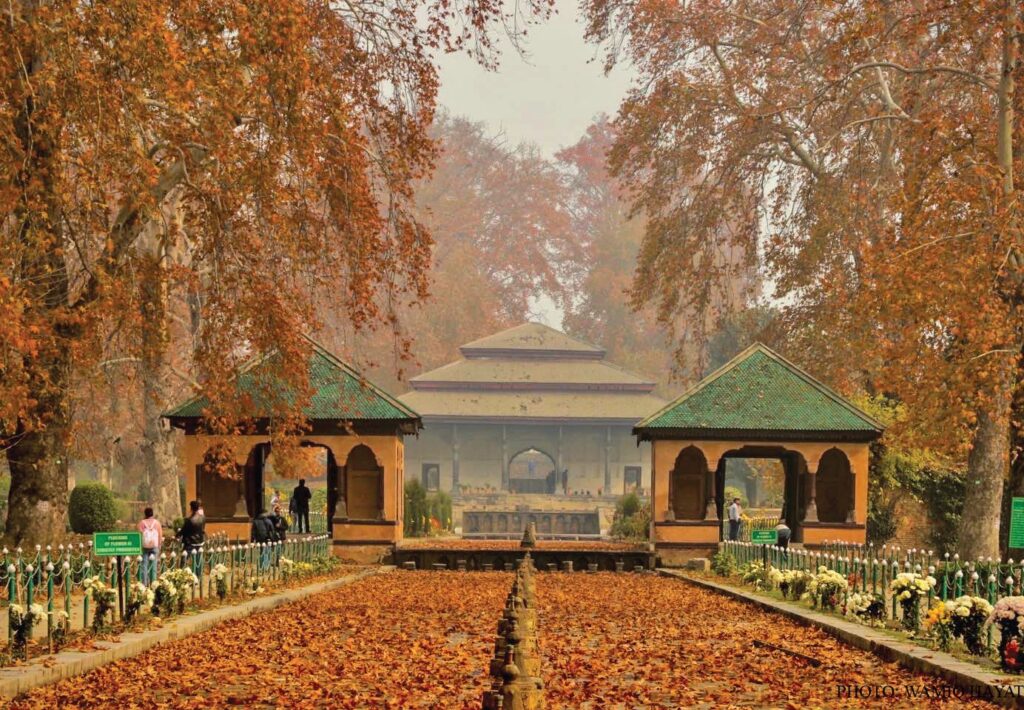
History books record Shalimar as Shah Jahan’s gift of love to Mumtaz Mahal. For Kashmiris, however, it’s where our most significant life events unfold against imperial grandeur.
Design and Daily Life
The garden’s design moves from public spaces (Diwan-e-Aam) to increasingly private areas (Diwan-e-Khas). This mirrors traditional progression of Kashmiri ceremonies. Outer gardens host community celebrations. In contrast, inner sanctums are reserved for intimate family gatherings.
During summer evenings, local musicians sometimes perform traditional folk songs near the central water channel. Their melodies carry across still water. In autumn, meanwhile, the garden becomes an outdoor classroom. Traditional storytellers narrate folk legends beneath trees heavy with golden leaves.
Shalimar Experiences
Local Experience: Visit on summer evenings when local school children practice traditional Kashmiri dance forms in open spaces. The garden’s natural terracing creates an amphitheater effect. Impromptu performances sometimes attract appreciative audiences. Furthermore, teachers usually happily demonstrate basic steps if you’re interested.
Craftspeople maintain the garden’s woodwork and stonework in early mornings. They use traditional tools and techniques unchanged for centuries. Therefore, respectfully observing their restoration work offers insight into preservation methods passed through generations.
Best Time to Visit: Late afternoons (3-5 PM) in summer (June-July). Families gather then for evening picnics. Marble pavilions take on a golden hue from the setting sun. Imperial design’s formal beauty becomes softened by children’s laughter. Meanwhile, they play traditional games along water channels.
Did You Know? The black marble throne in the central pavilion has precise positioning. It catches afternoon light to illuminate the emperor while subjects remained in shadow. This early stagecraft enhanced royal mystique. Today, nevertheless, young couples pose in the same spot for wedding photographs. They continue a tradition bridging imperial past and living present.
Chashme Shahi: Healing Waters
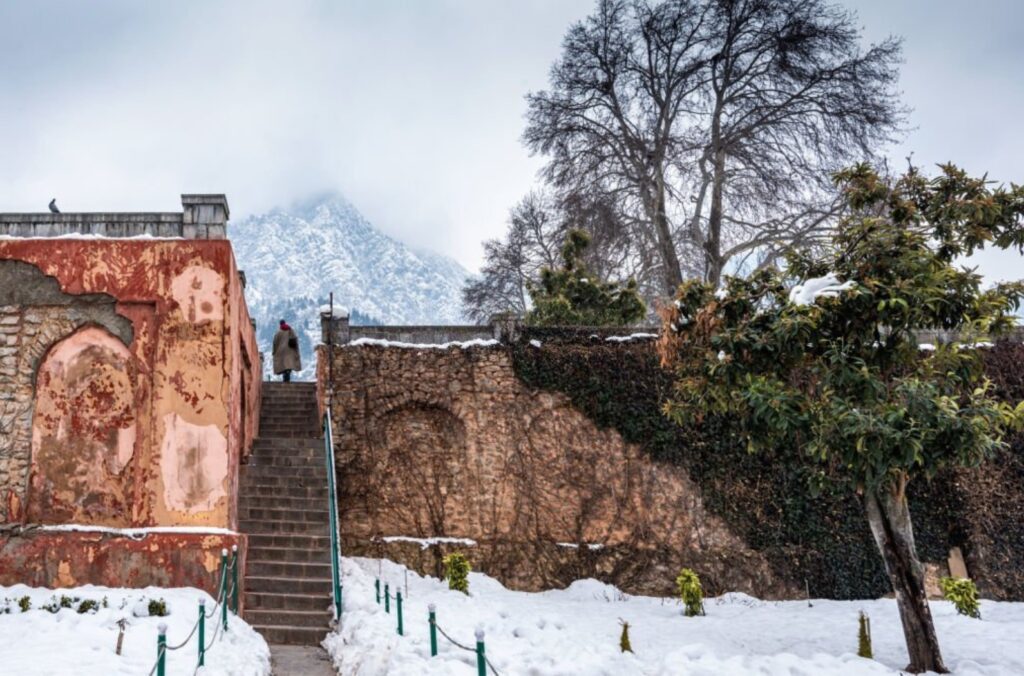
Chashme Shahi is the smallest of our major Mughal gardens. Yet it holds special significance for locals seeking medicinal benefits from its natural spring. The garden was built around this spring. Its waters reportedly cure digestive ailments.
Health and Heritage
For Kashmiris, this isn’t merely historical—it’s practical healthcare. My grandmother insisted on collecting Chashme Shahi water monthly. She claimed it was the only reliable remedy for her chronic indigestion. Local physicians still sometimes “prescribe” the spring water for certain conditions. Consequently, they blend modern medicine with traditional wisdom.
The terraced garden surrounding the spring demonstrates Mughal designers’ adaptation skills. They fitted Persian concepts to our mountainous terrain. Unlike larger gardens, Chashme Shahi feels intimate and personal. Thus, this quality makes it popular for quiet contemplation.
Chashme Shahi Experiences
Local Experience: Bring an empty bottle to fill from the main spring. Locals believe the water must be drunk fresh from the source for maximum benefit. You’ll often find residents discussing the water’s properties. Additionally, they compare it to other springs throughout the valley. Some families maintain decades-long records of which family members were “cured” by regular consumption.
A small tea shop near the entrance serves kehwa in traditional samovars. They add locally grown herbs according to season. Winter brings crushed almonds and extra saffron to warm the blend. In summer, however, fresh mint leaves provide cooling properties.
Best Time to Visit: Mid-mornings (9-11 AM) in autumn (September-October). The crowd thins then. Elderly Kashmiris often gather to collect water and exchange health advice. Furthermore, this impromptu community clinic welcomes respectful visitors.
Did You Know? When Jawaharlal Nehru was imprisoned in Kashmir in 1946, his declining health prompted a special prescription. Doctors recommended daily drinks from the Chashme Shahi spring. Palace guards collected the water each morning. This began a tradition that continued even after he became Prime Minister. Subsequently, special couriers would transport sealed containers of spring water to Delhi for his consumption.
Pari Mahal: Observatory of Knowledge
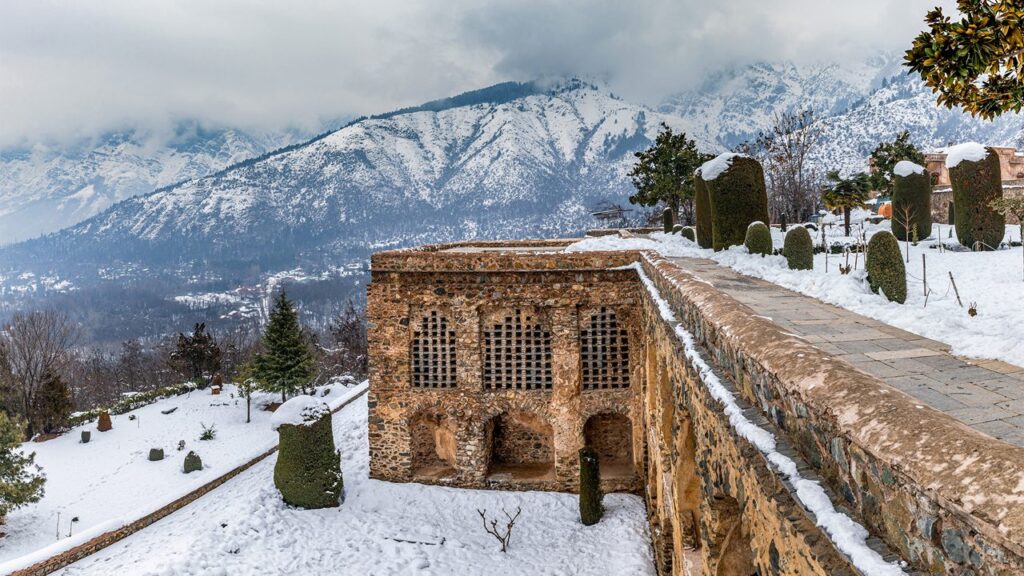
Pari Mahal sits high above ordinary tourist routes. This seven-terraced garden was built as an observatory and astrology school by Dara Shikoh. It represents our intellectual heritage. Visitors admire panoramic Dal Lake views below. However, locals know it as a place where mysticism and astronomical science once flourished together.
Astronomy and Art
The garden’s design incorporates subtle astronomical alignments. These mark solstices and equinoxes. Local astronomy enthusiasts still use these features for educational demonstrations. During clear winter nights, moreover, amateur stargazers gather here with telescopes. They benefit from reduced light pollution at this elevation.
The ruins also serve as an unofficial gathering place for Kashmiri poets and philosophers. On summer evenings, you might encounter informal mushairas (poetry recitations). Contemporary verses echo in spaces once dedicated to cosmic contemplation.
Pari Mahal Experiences
Local Experience: If visiting near sunset, bring a small notebook. Local tradition holds that insights recorded at Pari Mahal at dusk have special clarity. This belief stems from the site’s history as a learning place. Additionally, you’ll often see Kashmiri students studying here before important examinations. They continue a scholarship legacy spanning centuries.
Best Time to Visit: Late afternoons (4-6 PM) in autumn (September-November). Slanting light then illuminates the valley below in golden hues. Furthermore, local artists often set up easels to capture the spectacular panorama.
Did You Know? The garden incorporates subtle water collection systems. They harvest morning dew—an innovation attributed to Dara Shikoh’s interest in sustainable architecture. After heavy dew or light rain, watch for small channels. Consequently, they direct moisture to central collection points. This engineering feat still functions nearly four centuries after construction.
Beyond Gardens and Old City: Sacred Spaces That Define Our Identity
Hazratbal Shrine: Our Emotional Center
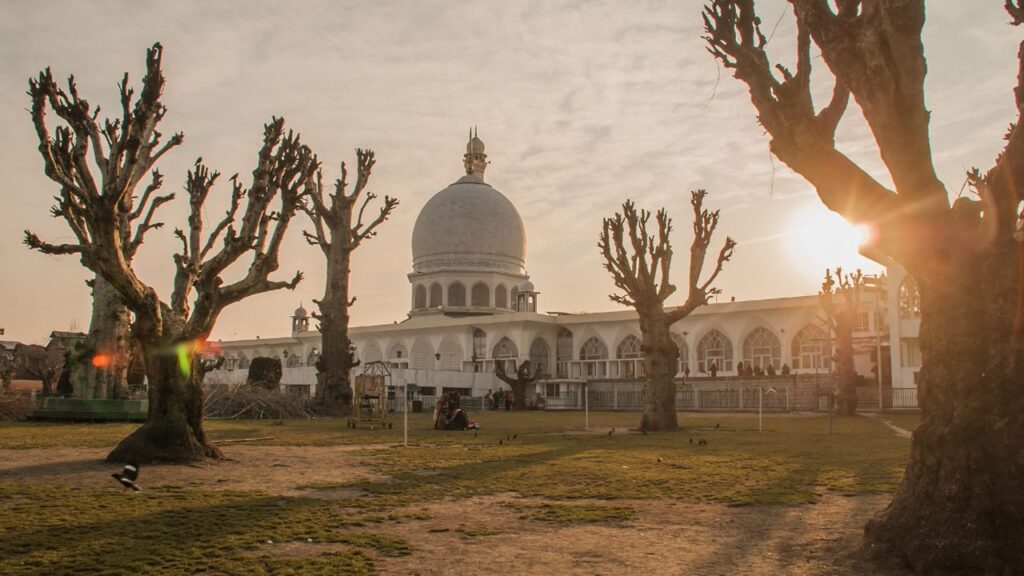
Hazratbal sits on Dal Lake’s northern shore. It’s architecturally unique as Kashmir’s only domed mosque. It’s also the emotional center of our religious identity. It houses the Moi-e-Muqqadas (a hair of Prophet Muhammad). The shrine transforms from tourist attraction to living spiritual hub throughout the day.
Community and Devotion
For locals, Hazratbal’s significance extends beyond marble architecture. It encompasses the community life pulsing around it. The surrounding market specializes in religious occasion items. These include prayer beads crafted from local woods, embroidered prayer mats, and traditional attar (natural perfumes) used for special observances.
During religious festivals, the sprawling grounds become a devotee sea. Sometimes hundreds of thousands travel from every valley corner. Even on ordinary days, prayer rhythms shape local life. As a result, businesses and activities pause in synchrony with the prayer call.
Hazratbal Experiences
Local Experience: Visit on Friday afternoon to witness the lakefront transformation. Devotees arrive by boat, bus, and foot. After prayers, the surrounding area becomes a community gathering space. In addition, families reconnect and discuss everything from marriages to business ventures.
Don’t miss special tandoor breads sold only at Hazratbal. The shirmal stands out—a slightly sweet bread flavored with saffron. Locals purchase it after Friday prayers. For instance, my family has bought our Friday shirmal from the same baker for three generations.
Best Time to Visit: Early mornings (7-9 AM) in winter (December-January). Mist rises from the lake then. Therefore, it creates an ethereal atmosphere as the white marble dome emerges from haze. The devoted gather for fajr (dawn prayer). Meanwhile, they arrive in small boats creating rippling pathways across still water.
Did You Know? During special occasions when the sacred relic is displayed, local families prepare massive copper vessels of tabarruk (blessed food). They make enough to feed thousands. This tradition ensures no visitor leaves hungry, regardless of faith or background. Consequently, my grandmother’s recipe for tabarruk rice with seven spices remains unchanged since her grandmother’s time.
Shankaracharya Temple: Ancient Sacred Heights
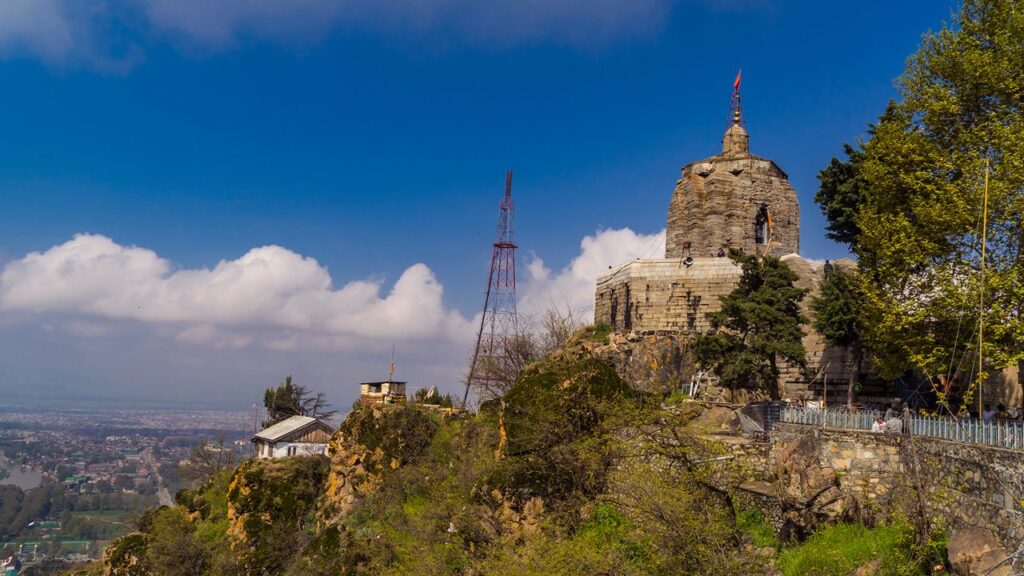
Shankaracharya Temple perches atop Shankaracharya Hill (locally called Takht-e-Suleiman). This ancient temple represents our valley’s layered religious history. It’s officially a Hindu temple dedicated to Lord Shiva. Nevertheless, local Muslims, Sikhs, and Buddhists also revere the site for its spiritual significance.
Stone Heritage
The temple’s stone construction is rare in our region. Wooden architecture dominates elsewhere. This speaks to its antiquity and importance. The arduous 243-step climb symbolizes spiritual journey in local tradition. Furthermore, each step represents progressive enlightenment.
For Kashmiri Pandits (Hindus), this temple maintains special significance. It symbolizes their deep historical valley roots. During Herath (Kashmiri Shivratri), the temple becomes a focal point. Community gatherings and rituals continue despite political changes and migrations.
Shankaracharya Experiences
Local Experience: Join early morning pilgrims who climb the hill before sunrise. Kashmiris of various faiths make this journey. They mark important life transitions—academic achievements, illness recoveries, or preparations for major journeys. Moreover, the shared climb often leads to conversations bridging cultural differences.
At the summit, observe how visitors interact with the space. Hindus perform traditional rituals inside the temple. In contrast, Muslims often meditate in the outer courtyard. This unconscious choreography demonstrates respectful coexistence. It characterizes Kashmir’s syncretic tradition.
Best Time to Visit: Early mornings (6-8 AM) in summer (May-June). The air is clear then. The panoramic view reveals the entire valley awakening. Additionally, local vendors sometimes set up small stands. They sell kehwa tea to early climbers—the perfect reward after ascending.
Did You Know? The stone used to construct the temple contains ancient fossils. They date back millions of years. You can see them in certain outer wall sections. Furthermore, local geologists occasionally lead educational tours. They point out these natural time capsules embedded within the sacred structure.
Navigating Srinagar Old City Like a True Kashmiri
Getting Around as Locals Do
Auto-Rickshaws: For exploring Srinagar Old City, hail one from designated stands. Don’t flag them on random streets. Ask the driver for their “fixed rate” rather than “meter rate.” Contrary to guidebook suggestions, the fixed rate often costs less for navigating complex Old City routes.
Walking: This offers the only authentic way to experience our narrow lanes. Remove your watch—time moves differently in Srinagar Old City. When you need directions, specifically ask shopkeepers rather than passersby. Because of their permanent presence, storekeepers possess encyclopedic neighborhood geography knowledge.
Local Secret: For destinations across the Jhelum River, consider small wooden boats that locals use. These traditional ferries cost much less than auto fare. Additionally, they provide unique riverside architecture perspectives.
Seasonal Wisdom From Generations
Spring (March-May): The perfect season for Srinagar Old City exploration. Artisans often work in open doorways then. As a result, their crafts become visible to passersby.
Summer (June-August): Focus on gardens in mornings and Srinagar Old City in evenings. Ancient stone pathways release the day’s heat then. Furthermore, shops stay open late.
Autumn (September-November): Photographers dream of this season. Golden chinar leaves create natural confetti against historical buildings.
Winter (December-February): Heavy snow transforms Srinagar Old City into a medieval wonderland. Join locals gathering around kangris (fire pots). Subsequently, they hold impromptu storytelling sessions in market squares.
Time-Tested Route Through Srinagar Old City
Begin at Maharaj Gunj at 8 AM for the morning bread ritual. Then work through Zaina Kadal to witness artisans starting their day. Reach Jama Masjid by late morning. After that, enjoy lunch at Ahdoos in Lal Chowk (order traditional wazwan). Afternoon deserves Nishat Bagh’s terraced splendor. Finally, conclude at Pari Mahal for sunset valley views.
Food Discoveries
Street Food Wisdom: The best tujj (grilled skewers) come from a small unnamed stand near Khanyar crossing. Look for the copper grill burnished mirror-bright from decades of use. For authentic Kashmiri halwa paratha, bypass Lal Chowk tourist traps. Instead, seek the vendor at Maharaj Gunj and Saraf Kadal junction corner. His family has maintained the same recipe since my grandfather’s childhood.
Our Srinagar Old City Tells a Story
My Srinagar Old City is more than picturesque Dal Lake houseboats and camera-ready gardens. It lives in apprentices carefully learning traditional khatamband ceiling patterns in dusty workshops. It breathes in muezzin calls echoing across rooftops at dawn. Moreover, it tastes like noon chai sipped from copper cups while discussing politics and poetry equally.
By venturing beyond postcard views into Srinagar Old City’s living lanes, you’ll glimpse authentic Kashmir. Experience our gardens as community spaces rather than tourist attractions. See the Kashmir that has survived emperors and empires. It has flourished through centuries of artistic evolution. Finally, it maintains unique character despite modern pressures.
Let weathered hands of our papier-mâché masters guide you. Let whispered prayers at our shrines inspire you. Meanwhile, watch children playing traditional games in ancient courtyards. They’ll show you the Srinagar Old City we know and love—unchanged in our hearts even as the world transforms around us.
